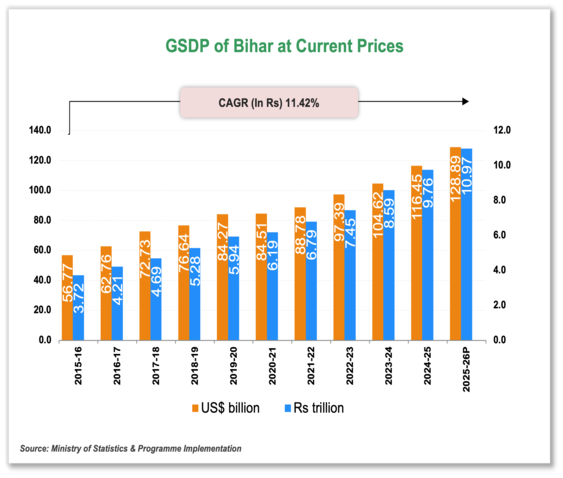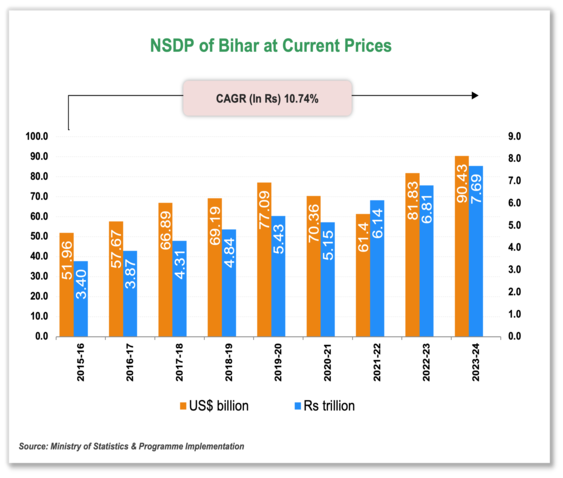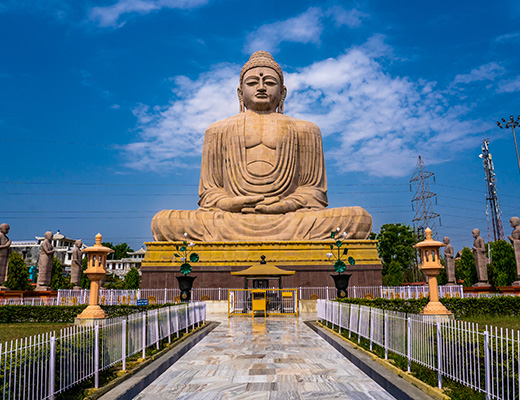Bihar
Bihar is the fourth largest producer of vegetables and the eighth largest producer of fruits in India.


Introduction

Bihar is located in the eastern part of India. The state is surrounded by Nepal in the north, West Bengal in the east, Uttar Pradesh in the west, and Jharkhand in the south.
The state enjoys a unique location-specific advantage because of its proximity to the vast markets of eastern and northern India, access to ports such as Kolkata and Haldia, and to raw material sources and mineral reserves from the neighbouring states.
In 2025-26, Bihar’s GSDP at current prices is projected to be Rs. 10.97 trillion (US$ 128.89 billion) and increased at a CAGR (in Rs.) of 11.42% between 2015-16 and 2025-26.
The per capita GSDP of Bihar increased to Rs. 66,828 (US$ 785.47) in 2023-24 and rose at a CAGR of 9.13% (in Rs.) between 2015-16 and 2023-24.
Bihar has witnessed strong growth in per capita net state domestic product. At current prices, the per capita NSDP of the state grew at a CAGR of 8.45% (in Rs.) between 2015-16 and 2021-22.
Bihar is one of the strongest agricultural states in the country. The percentage of the population employed in agricultural production in Bihar is around 80%, which is much higher than the national average. It is the fourth-largest producer of vegetables and the eighth-largest producer of fruits in India. Food processing, dairy, sugar, manufacturing, and healthcare are some of the fastest-growing industries in the state. The state has planned initiatives for the development of other sectors such as education and tourism and provides incentives for information technology and renewable energy projects.
The state has a large base of cost-effective industrial labour, making it an ideal destination for a wide range of industries.
Total merchandise exports from the state stood at Rs. 15,987 crore (US$ 1,878.36 million) in FY25 (until February 2025). Key items exported from the state included petroleum products, buffalo meat, other cereals and rice (other than basmati).
In FY25, Bihar had a total installed power generation capacity of 7895.25 MW, of which 6655.99 MW was contributed by central utilities, 70.70 MW by state utilities and 1168.56 MW by private utilities.
Hydropower plants accounted for a power generation capacity of 110 MW, while 450.15 MW of installed power generation capacity was from renewable sources.
Recent Developments in Key Sectors
- According to the Telecom Regulatory Authority of India (TRAI), Bihar had 94.65 million wireless subscribers and 1.19 million wireline subscribers, as of September 2024.
- According to the Department for Promotion of Industry and Internal Trade (DPIIT), cumulative FDI inflows in Bihar were valued at US$ 215.76 million between October 2019- December 2024.
- The state government has approved a scheme to provide a grant of Rs. 2 lakh (US$ 2,392) to poor households for setting up a small business. The estimated budget allocation for this initiative is Rs. 1,000 crore (US$ 120 million) in FY25, aiming to improve the financial condition of underprivileged households by supporting them in establishing their own small enterprises.
- In 2023, education and the rural sector get top priority in Bihar’s US$ 31.78 billion (Rs 2.61 lakh crore) Budget.
- In September 2022, to lessen the burden on children, the Bihar government decided to mandate a games period at least once a week and a "no-bag day" policy in schools.
- In September 2022, the Bihar Cabinet approved a plan to increase the state's medical infrastructure by adding some 8,000 posts in government medical colleges and hospitals.
- In Bihar, as of April 2022, over 100,000 farmers have been educated with climate-resilient agricultural methods since a pilot project was launched for this purpose in 2019 across 40 villages in eight districts.
- Under the State Budget 2025-26:
- Rs. 8,832 crore (US$ 1.04 billion) was allocated towards roads and bridges.
- Rs. 13,401 crore (US$ 1.57 billion) was allocated for the energy department.
- Rs. 10,928 crore (US$ 1.28 billion) has been allocated for urban development.
- Rs. 63,335 crore (US$ 7.44 billion) was allocated towards the education, sports, art and culture sectors.
- Rs. 19,184 crore (US$ 2.25 billion) was allocated towards health and family welfare.
- Rs. 8,039 crore (US$ 944.54 million) was allocated towards agriculture and allied activities.
- In February 2022, Minister of Port, Shipping and Waterways, Mr. Sarbananda Sonowal, laid the foundation stone for Bihar’s first intermodal inland waterways cargo terminal at Kalughat near Sonepur in the Saran district.
- In February 2022, Chief Minister of Bihar, Mr. Nitish Kumar, and Minister of Road Transport and Highways, Mr. Nitin Gadkari, jointly inaugurated a 14.5 km approach road to Munger rail-cum-bridge that cost Rs. 696 crore (US$ 90.94 million).
- In Bihar, road work worth Rs. 30,000 crore (US$ 4.06 billion) is undergoing. For compensation against land acquisitions, a total of Rs. 4,600 crore (US$ 621.81 million) has been announced.
- By 2023, a 7-km four-lane Koshi bridge worth Rs. 1478 crore (US$ 199.79 million) is likely to be constructed.
- As of February 2025, Bihar is implementing 57 railway projects worth Rs. 86,458 crore (US$ 10.16 billion), covering 5,346 km of new lines, doubling tracks, and gauge conversion. Additionally, 98 Amrit Bharat stations are being redeveloped at a cost of Rs. 3,164 crore (US$ 372 million) Since 2014, Bihar has achieved 100% electrification with 3,020 km of tracks electrified. Twelve Vande Bharat trains and one Amrit Bharat Express are now operational.
- On October 20, 2024, Prime Minister Mr. Narendra Modi laid the foundation stone for a Rs. 912 crore (US$ 107.16 million) civil enclave project at Darbhanga Airport. The civil enclave at Darbhanga Airport will significantly enhance air connectivity for the Mithila region and northern Bihar.
- At Patna's Jayaprakash Narayan International Airport, >26.75% work on a new domestic terminal building and other auxiliary facilities has been completed, as of August 2021. The Airports Authority of India (AAI) has been given Rs. 1,216.9 crore (US$ 166.09 million) by the Central Government for the redevelopment project, which is expected to be completed by December 2023.
- Sugarcane is grown in approximately 6% of the total area under cultivation in Bihar. Sugarcane production in the state for 2018-19 (P) stood at 182.85 lakh MT. During sugar season 2019-20, 11 sugar mills were operating in the state of Bihar. In FY22, Bihar exported US$ 6.35 million worth of sugar.




